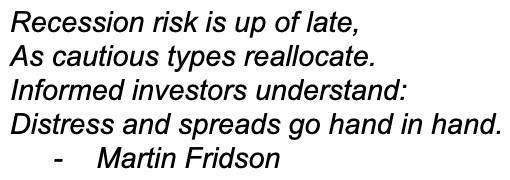| Below, you’ll find the latest market update and portfolio review from Porter & Co.’s Director of Distressed Investing, Martin Fridson. We release a full report with a new recommendation on the second Thursday of each month, and an update like this one two weeks later. Marty also provides the “Top 3 Best Buys” – a regular feature that highlights what he views as the three most attractive positions to focus on in the portfolio, to help those who are new to distressed investing get started. As always, please call Lance James, our Director of Customer Care, with any questions. You can reach him and his team at 888-610-8895, or internationally at +1 443-815-4447. |

Stocks attracted a great deal of attention earlier this month as the S&P 500 dropped by 10% – the definition of a market correction – from February 19 to March 13. As is usually the case, bonds’ performance during what was a rough time for equities received considerably less notice. But their behavior as equities sank is worth examining, especially by investors who don’t know about the benefits of distressed bonds.
The price of U.S. Treasuries constitutes the bond market’s foundation, supplying reference points for all other types of bonds. As stocks were falling between mid-February and mid-March, Treasury bond prices rose by 1.62%, as measured by the ICE BofA U.S. Treasury Index. The yield on that index, which declines as the price rises, dropped from 4.44% to 4.18%.
Treasury bonds thereby fulfilled their classic role in a balanced portfolio – namely, supplying downside protection. Over the three weeks when stocks sold off by 10%, economic forecasters (surveyed by Bloomberg) increased their estimate of the probability of a U.S. recession within 12 months from 20% to 25%. In part due to the concern about those higher odds, investors fled equities for the safety of high-quality bonds. That caused Treasury-bond prices to rise, offsetting some of the damage to their portfolios inflicted by plunging stock valuations.
It was a somewhat different story for speculative-grade bonds, also known as “high-yield” or, less flatteringly, “junk.” Unlike the Treasury-bond index, which rose, the ICE BofA U.S. High Yield Index’s price dipped by 1.12%. Why did high-yield bond prices fall while Treasury bond prices went up?
As mentioned above, Treasuries are a reference point for pricing all other bonds (and, for that matter, all other financial assets). Buyers of corporate bonds, including the speculative-grade variety, demand extra yield above the prevailing Treasury rate as compensation for the risk of default. The yield premium, or spread, also compensates investors for the fact that corporate bonds don’t have as deep and liquid a market as Treasuries do. That creates the risk that in a falling bond market, holders won’t be able to limit their loss by selling quickly.
Default rates rise sharply during recessions, so the mere fact that a recession had become more likely in the near term drove up the high-yield index’s spread over Treasuries from +268 basis points to +340 basis points (1 basis point = 1/100 percentage point). That increase more than offset the decrease in the underlying Treasury rate, so the net effect was an increase in the high-yield index’s yield from 7.00% to 7.45%. Hence the price drop – although much smaller than on the S&P 500 – on speculative-grade bonds.
Another dynamic affecting the speculative-grade universe between February 19 and March 13 was an increase in the distress ratio from 3.95% to 5.69%. That’s defined as the percentage of bonds in the high-yield index trading at distressed levels, as indicated by spreads-versus-Treasuries of 10 percentage points or greater. March 13’s 5.69% distress ratio was far below the 30%-plus level generally observed during actual recessions. But the rise means that the opportunities for distressed investors are becoming more plentiful.
The two data series discussed in this report are displayed together in the accompanying graph. It shows that they generally rise and fall in tandem. Statistics reinforce that visual impression. The high-yield spread and the distress ratio have a 97.5% correlation. As spreads increase on speculative-grade bonds in general, more issues get pushed into the distressed range of 10 percentage points or more.

Will the high-yield spread – and by extension the distress ratio – continue to rise, or will it recede to the lower level seen earlier in 2025? We’ll take the over on that bet – we think it will rise.
One additional factor driving the increase of these two series is a tightening of banks’ credit standards, as we discussed last month. Whichever series one relies on, the trend points toward a wider selection of plays in distressed bonds.
This content is only available for paid members.
If you are interested in joining Porter & Co. either click the button below now or call our Customer Care team at 888-610-8895.